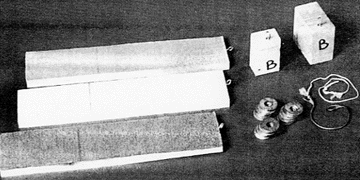 |
 |
|
|
|
|
5th Grade Performance Task
Description:Students are asked to formulate a hypothesis and design an experiment to examine the relationship between block weight and the number of washers required to pull a block across various surfaces. After performing their experiment, students are asked to graph results from a described experiment and to apply their findings to a practical situation.The task assesses students' abilities to develop a hypothesis, design an experiment, utilize experimental data, and apply their understanding to an additional situation. This task is designed to take students approximately 45-60 minutes to complete.
Overall Task Content Area:
Specific Knowledge Areas:
Performance Expectations:
National Science Education Standards:8 B PS 2: Motions and Forces: Grades 5-82.3 If more than one force acts on an object along a straight line, then the forces will reinforce or cancel one another, depending on their direction and magnitude. Unbalanced forces will cause changes in the speed or direction of an object's motion. 8 A SI 1: Abilities necessary to do scientific inquiry:
Grades 5-8 1.4 Develop descriptions, explanations, predictions, and
models using evidence. Students should base their explanation on
what they observed, and as they develop cognitive skills, they should
be able to differentiate explanation from description — providing
causes for effects and establishing relationships based on evidence
and logical argument. This standards requires a subject knowledge
base so the students can effectively conduct investigations, because
developing explanations establishes connections between the content
of science and the contexts within which students develop new knowledge.
(Use the "hot" link on the PALS home page to check the full text of related National Science Education Standards, if desired.) National Council of Teachers of Mathematics:AL1: Understand patterns, relations and functions:
AL4: Analyze change in various contexts: DAP3: Develop and evaluate inferences
and predictions that are based on data: PS2: Solve problems that arise in mathematics and in
other contexts:
General Instructions to the Teacher:This task is designed to take students approximately 45-60 minutes to complete. Students will be working individually during this exercise. Students should be ready to work as soon as the period begins. The materials should be set out at each lab station, if possible. A central supply area, if needed, should be easily accessible. All supplies should be clearly labeled.
Materials for Friction:The teacher will need:
At this station students should have:
Advance Preparation:
Safety:
Extensions/modifications:

|